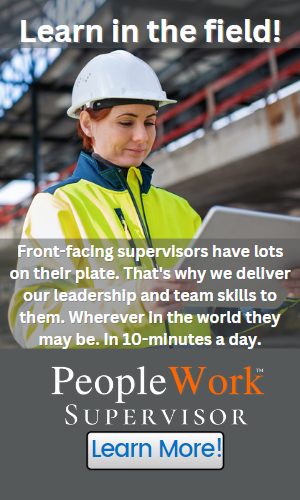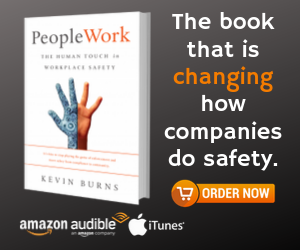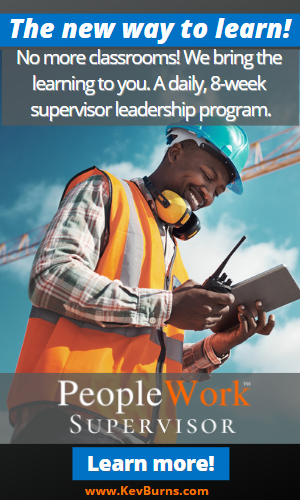Are Expectations More Effective Than Safety Rules?
Employers, managers and supervisors who do not set clear expectations for their teams are already at a disadvantage. Without a set of clear expectations, you can expect your people to fumble around trying to figure out what’s important to their employers. When people are fumbling to figure out what is important, safety is going to falter.

Employees let loose in their workplaces without clear expectations are being set up for failure, not success.
Gallup polling suggests that half of all workers have no clear understanding of what is expected of them. And without expectations, there is little engagement. Where engagement lacks, safety falters. Think about it, how can you expect employees to be engaged in safely doing work for which there are no clear expectations?
What do you expect?
While we’ve been clear in establishing safety rules, procedures and processes, we have lacked at clearly articulating what we expect from our people.
“No one gets hurt” is not a clear set of instructions. It is an intended outcome. But it is not a clear expectation of the actions we want our people to take.
What specifically do you want your people to do that they are not doing now? What actions, teamwork, or character traits do you want them to demonstrate? How do you want them to treat their fellow workers specifically?
Telling your people that you want them to look out for each other is also not actionable. How do you want them to look out for each other specifically? Because if the expectation of how they are going to do that is not clear, what one employee interprets will not be the same as the next.
Individual perspectives are different.
Ask ten people to picture a dog and you will get ten different breeds in response. Ask ten people what “looking out for their fellow team members” means and you will get ten different answers. So, show them specifically. Be clear in your expectations.
You want to set your people up to win, just like a sports team. Every player on the team plays by the same set of rules but the expectations for each player may vary. How the team plays as a unit though, the expectations are usually very clear.
Expectations versus rules.
You can get your people to follow safety rules by simple, brute-force enforcement. But that makes for an awful place to work. And you would likely get just bare-minimum compliance, enough to meet the letter of the law.
Expectations, however, can raise the bar on minimum safety rules. Expectations have a feeling, a mindset, and a goal attached. Expectations create a winning safety culture. Rules create consequences.
Truthfully, most employees will do what is expected of them. They will rise to accomplish what is expected. So, let’s be very clear in communicating what you expect. Rules adherence is only part of what you expect.
Supervisory expectations are important.
The greatest numbers of employees are at the front-line. The greatest amount of activity occurs at the front-line. The greatest numbers of safety incidents occur at the front-line. Therefore, under their watch, supervisors have to be even more clear and identify their expectations of each member of the team.
Then, with the backing of the team, supervisors must engage their teams to lay out the expectations for each other. When that expectation is also agreed to by all team members, then it becomes the basis of how they work together. And any new member to the team quickly gets up to speed on “how we do things ‘round here.”
What you won’t stand for.
The best place to start in establishing team expectations is to start with what you won’t accept. Let the team sort this out for themselves but asking them about things they themselves are uncomfortable with is a place to start.
Harassment (sexual and racial), showing up unfit for duty, hiding your hangover, or a “good enough” attitude towards quality work are places to start. Putting respect and caring for everyone at the top helps workers to feel safe among their team members. When employees feel safe, they are more likely to act safely.
Once you create an expectation, you set a higher standard that over time it becomes impossible to return to old standards. And when people agree to work at a higher standard, it will most certainly include safety.
Safety and production are not separate.
You can’t sustain high quality work by employing low quality safety performance. But safety rules alone are not enough to make production and safety work together effectively. Rules are only meant to achieve the bare minimum.
Instead, set clear expectations beyond the minimum - especially from supervisors. Over time, those expectations will set a new standard. And it will help create buy-in from your team that will make it all work together.
That is why the Safety Communications & Coaching for Supervisors Program (SCCS) was created. Taking your entire team of supervisors and middle managers through this 12-week program can create the solid footing your supervisors need. It is not a program about having clever things to say or to get employees to blindly comply with safety rules. SCCS is designed to be a culture-shift program by establishing clear expectations for employees and the supervisors themselves.
Go to KevBurns.com/SCCS to find out how your company can benefit and to see how it works.
--
Kevin Burns is the President/CEO of KevBurns Learning. Kevin works with smart, caring companies to energize safety culture, build teamwork, and improve employee participation in safety.
In 2020, BookAuthority.org named PeopleWork #7 of The Top 44 Workplace Safety Books of All Time. Buy yourself a copy of PeopleWork: The Human Touch in Workplace Safety and give another as a gift to a colleague.
Subscribe to Kevin’s Blog.






